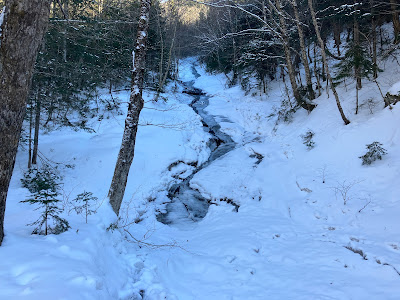When I saw timbercamp's December 12th NETC report on his snowshoe climb of the North Slide of Mount Tripyramid, I was encouraged by the mention of good snow cover out that way. Avalanche Ravine, the sharp valley at the head of Avalanche Brook out by the North Slide, tends to be a good snow pocket and is one of my favorite snowshoeing locales. Rather than do a spike hike on a bony, icy trail, I decided to head out there and lug the snowshoes in hope of finding some good 'shoeing. I was not disappointed.
The first 2.2 miles of the wide Livermore Trail had just a couple inches of snow atop hardpack and ice, but the footing was choppy. I paused briefly at the Depot Camp clearing to peek at Middle and South Tripyramid.
Beyond the junction with the Upper Snows Mountain X-C Trail, there had been much less traffic on Livermore Trail. The single track that had been made was a boot-churned mess, frozen in place. I followed timbercamp's lead, donning my snowshoes and following his imprints in the soft grainy snow beside the track.
The upper part of White Cascade on Slide Brook was running free.
Making tracks on a Livermore Trail straightaway.
A fine sunny day, if a bit chilly, at the Avalanche Camp clearing.
At the junction with the north end of the Mount Tripyramid Trail, I opted to avoid the frozen divots of the trail and instead follow a favorite bushwhack route on the opposite (north) side of Avalanche Brook.
This route mostly follows an old, overgrown logging road, probably dating back to the Parker-Young Company operation in the 1930s/1940s.
Farther along, the old road breaks out into a sunny and spacious hardwood glade.
The snowshoeing was superb through here on supportive snow with a layer of powder on top. Definitely worth the price of admission.
I always find it a bit of a challenge to make a winter crossing of this little brook, which drains the ravine below the Scaur Ridge Trail.
After an obscure section on the far side of the brook, the old road continues up into the ravine.
Despite the recent heavy rain, there was still a good early season snowpack in here.
The North Slide looked cold and forbidding, poised high above the ravine floor.
This glade is an inner sanctum of the ravine.
Avalanche Brook, almost buried.
Sweet snowshoeing.
Plan B was to bushwhack another quarter-mile up the ravine to the remnant open patches on one of several smaller slides that came down in the same August 1885 storm that triggered the huge North Slide. This entailed a rather steep angling climb through thicker woods...
...but with occasional open stretches as well.
The crusty, supportive snow was a boon for this bushwhacker.
These prints were old and muted, but they kept my streak of seeing bear tracks on every recent bushwhack alive.
This was a fairly sizeable slide after it fell in 1885, but 138 years later only a few small open patches remain. The revegetation on this slide appears to be 99% red spruce. No white pines were seen.
I climbed to the upper end of a snowy open strip and enjoyed a late lunch while admiring a view of the Osceolas, with Mount Moosilauke rising beyond Thornton Gap. Various spurs of Scaur Ridge are in the foreground.
Closer look.
Descending the open slide strip.
The slide I visited is the second from the left in this 1910 photo by Edward H. Lorenz. Note how vast both the main North Slide and its east fork were back then.
(Photo courtesy of Town of Waterville Valley)
Following my tracks back to the base of the east fork of the North Slide.
Heading back down the floor of the ravine.
Looking back, the ravine headwall was illuminated by the late-day sun.
An impressive yellow birch.
Long shadows in the hardwoods.
Fiery sun along the Livermore Trail.
Painted sky.


































Steve, a great account of a glorious day. Thank you.
ReplyDelete